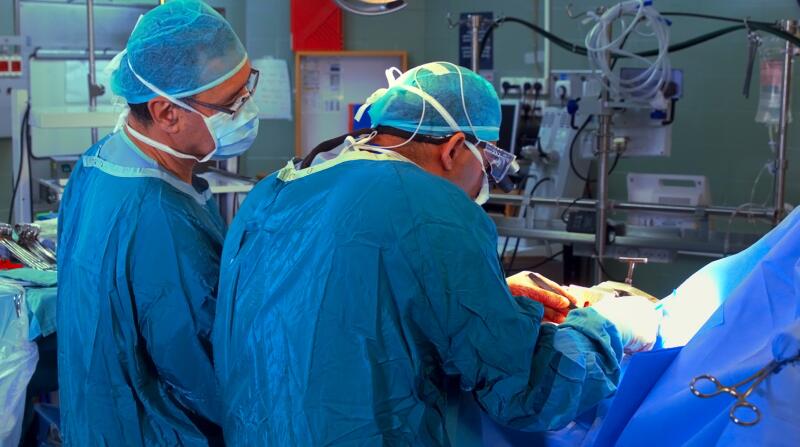PHYSICIAN VOICES
5 Differences Between TAVR and Surgery for Severe Aortic Stenosis
-
 Treating Aortic Stenosis: Know Your OptionsOne of the most common forms of heart valve disease is called aortic stenosis, also known as a heart valve failure, which is a narrowing of the aortic valve opening caused by scarring and calcium build up over time. Aortic stenosis restricts the amount of blood exiting the heart and can result in serious medical consequences, such as a heart attack. The only way to treat aortic stenosis is to replace the valve, and there are two main replacement techniques performed: SAVR (surgical aortic valve replacement), which uses open-heart surgery, and TAVR (transcatheter aortic valve replacement), where the doctor uses an artery to carry the new valve to the heart. There are many differences between the two procedures, and your doctor will consider these when deciding which is best for you.
Treating Aortic Stenosis: Know Your OptionsOne of the most common forms of heart valve disease is called aortic stenosis, also known as a heart valve failure, which is a narrowing of the aortic valve opening caused by scarring and calcium build up over time. Aortic stenosis restricts the amount of blood exiting the heart and can result in serious medical consequences, such as a heart attack. The only way to treat aortic stenosis is to replace the valve, and there are two main replacement techniques performed: SAVR (surgical aortic valve replacement), which uses open-heart surgery, and TAVR (transcatheter aortic valve replacement), where the doctor uses an artery to carry the new valve to the heart. There are many differences between the two procedures, and your doctor will consider these when deciding which is best for you. -
 1. TAVR is safer than SAVR for some patients.TAVR, which is approved for severe aortic stenosis patients, was originally designed for people considered too frail to survive open-heart surgery or people who had other issues preventing them from undergoing the more intensive procedure.
1. TAVR is safer than SAVR for some patients.TAVR, which is approved for severe aortic stenosis patients, was originally designed for people considered too frail to survive open-heart surgery or people who had other issues preventing them from undergoing the more intensive procedure. -
-
 2. Unlike SAVR, TAVR is a “beating heart” procedure.In open-heart surgery, the surgeon must crack open the patient’s breastbone to insert a new valve while keeping the patient on a heart-lung bypass machine. This machine keeps blood circulating in the body even while the heart is completely stopped for the procedure. But TAVR is a “beating heart” procedure, performed without stopping the heart, so a heart-lung bypass machine is unnecessary. Though less invasive than open-heart surgery, TAVR is still a major heart procedure that carries potential risks like stroke, kidney failure and vessel damage
2. Unlike SAVR, TAVR is a “beating heart” procedure.In open-heart surgery, the surgeon must crack open the patient’s breastbone to insert a new valve while keeping the patient on a heart-lung bypass machine. This machine keeps blood circulating in the body even while the heart is completely stopped for the procedure. But TAVR is a “beating heart” procedure, performed without stopping the heart, so a heart-lung bypass machine is unnecessary. Though less invasive than open-heart surgery, TAVR is still a major heart procedure that carries potential risks like stroke, kidney failure and vessel damage -
 3. TAVR is minimally invasive, whereas SAVR is quite invasive.The TAVR valve is delivered to the heart through a catheter, or a long tube, inserted into an incision made into an artery, typically near the groin. The catheter then sends the new valve via the artery to the heart, where it displaces the diseased valve and begins working immediately. In SAVR procedures, the diseased valve is removed and the new valve is inserted directly by cutting the chest open.
3. TAVR is minimally invasive, whereas SAVR is quite invasive.The TAVR valve is delivered to the heart through a catheter, or a long tube, inserted into an incision made into an artery, typically near the groin. The catheter then sends the new valve via the artery to the heart, where it displaces the diseased valve and begins working immediately. In SAVR procedures, the diseased valve is removed and the new valve is inserted directly by cutting the chest open. -
 4. With TAVR, patients spend less time under anesthesia than SAVR.Because the procedure is shorter and less intensive, anesthesia time is also much shorter with TAVR than surgery for aortic stenosis. More recently, many TAVR procedures are performed with “conscious sedation.” This method uses a combination of sedatives and anesthetics in minor surgeries to help the patient relax and tolerate the procedure. Using conscious sedation also helps to dramatically cut down on recovery time after TAVR.
4. With TAVR, patients spend less time under anesthesia than SAVR.Because the procedure is shorter and less intensive, anesthesia time is also much shorter with TAVR than surgery for aortic stenosis. More recently, many TAVR procedures are performed with “conscious sedation.” This method uses a combination of sedatives and anesthetics in minor surgeries to help the patient relax and tolerate the procedure. Using conscious sedation also helps to dramatically cut down on recovery time after TAVR. -
 5. It takes much longer to recover after SAVR than after TAVR.Open-heart surgery is intensive, involving significant hospitalization and potentially months of recovery time. Conversely, patients can typically be discharged home just a few days after undergoing the TAVR procedure. Because TAVR is performed without breaking the breastbone to operate on the heart, patients have a much easier recovery. However, while TAVR has been approved for any individual with aortic stenosis, SAVR may still be a better option based on different factors. You and your doctor will decide which procedure is best for you.
5. It takes much longer to recover after SAVR than after TAVR.Open-heart surgery is intensive, involving significant hospitalization and potentially months of recovery time. Conversely, patients can typically be discharged home just a few days after undergoing the TAVR procedure. Because TAVR is performed without breaking the breastbone to operate on the heart, patients have a much easier recovery. However, while TAVR has been approved for any individual with aortic stenosis, SAVR may still be a better option based on different factors. You and your doctor will decide which procedure is best for you. -
Your Opinion Matters!
In order to improve our content, we want to hear from you. Please take this short anonymous survey to let us know how we’re doing.
Take the survey!
5 Differences Between TAVR and Surgery for Severe Aortic Stenosis









